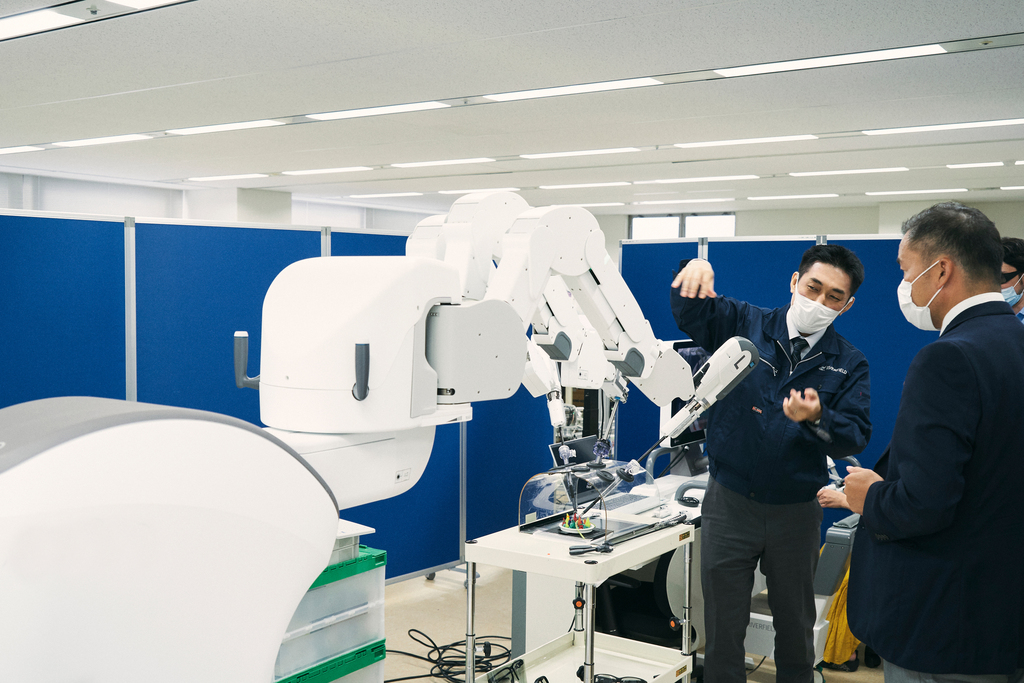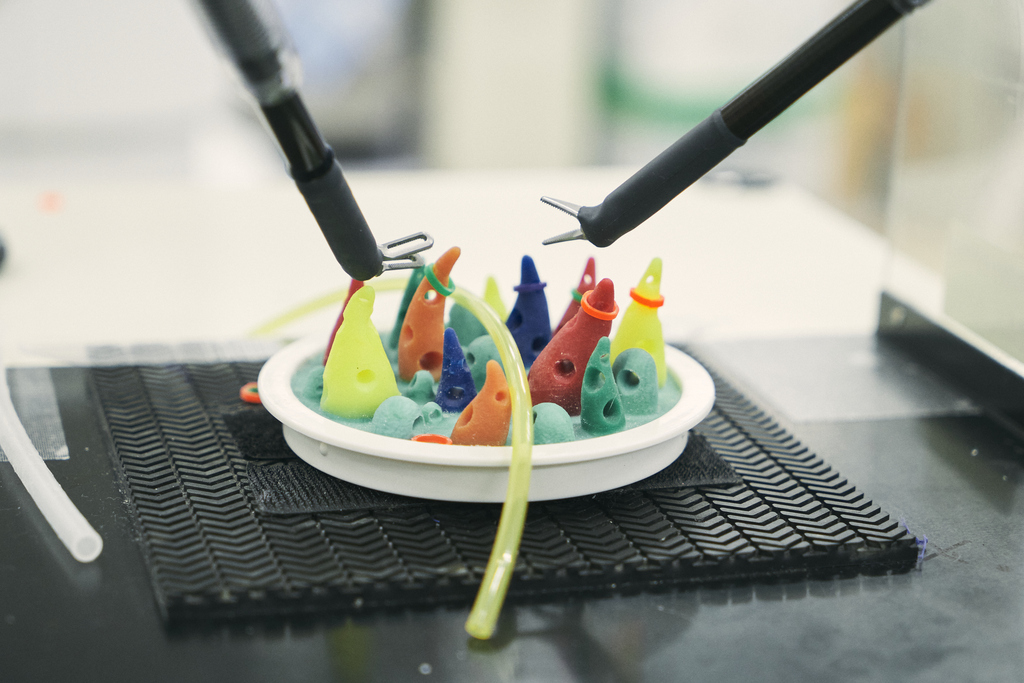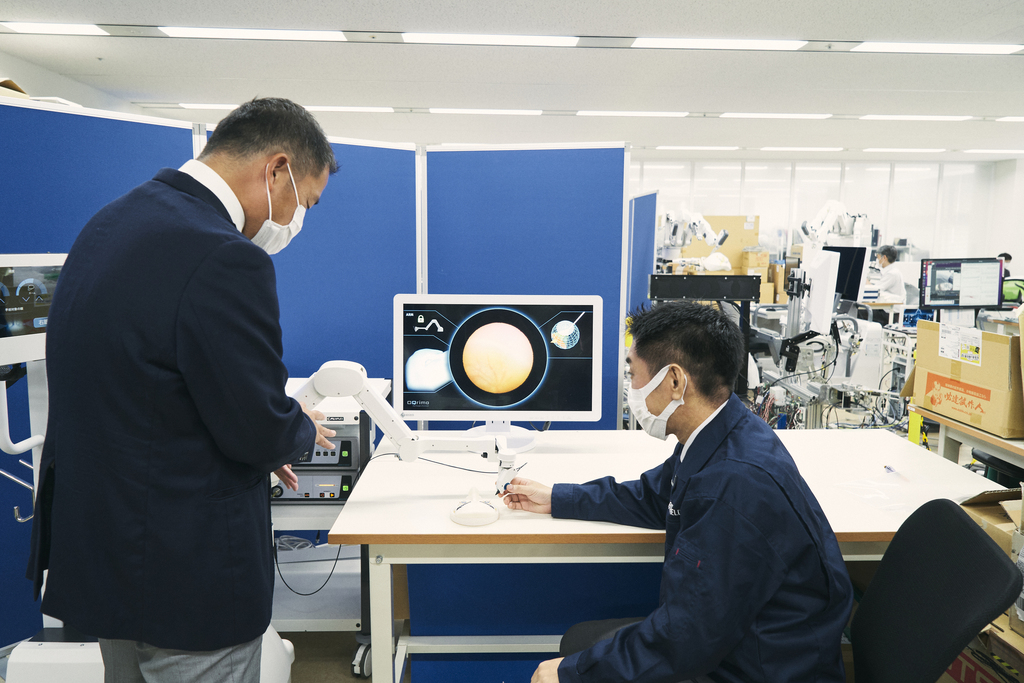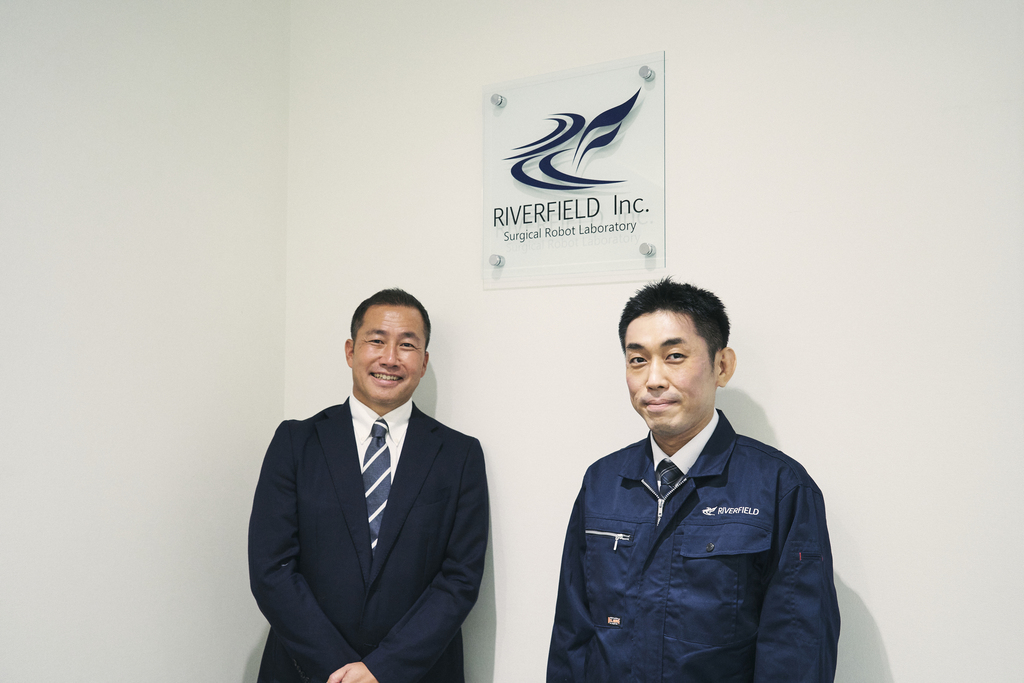Note: This website was automatically translated, so some terms or nuances may not be completely accurate.
Aiming for "Divine Hand"-Level Surgery with "Pneumatic Control": What Future Does Next-Generation Robotics Unlock for Healthcare? (Part 2)

Hayashi Tsuyoshi
Dentsu Medical Communications Inc.

Kotaro Tadano
Riverfield Co., Ltd.
Medical robots are gaining attention as one potential solution to challenges in the healthcare field, such as physician shortages and disparities in medical care between urban and rural areas, as well as between large hospitals and smaller facilities. In the field of "surgical assistance robots," where doctors remotely operate robots while viewing 3D images to perform surgeries, Riverfield Inc. is developing unique robots utilizing "pneumatic" technology. This is the second part of a discussion between Kotaro Tadano, President and CEO of Riverfield, and Tsuyoshi Hayashi, President and CEO of Dentsu Medical Communications Inc., who partners with clients in the medical and healthcare sector to advance businesses that contribute to better patient lives.
In the first part, we discussed the haptic feedback for robot operators enabled by pneumatic sensors, the journey to technological development, and the environment surrounding medical robots. In this second part, we delve deeper into the challenges facing the adoption of medical robots and the vision Mr. Tadano aims to achieve.
Easier to operate than driving a car. An era where anyone can become a super doctor
Hayashi: I understand the global demand for medical robots, including surgical assistance robots, is growing. How is the adoption rate in Japan?
Tadano: I'd say adoption rates are around 30% at large hospitals in major cities, but less than 10% at regional or mid-sized hospitals.
Hayashi: Is that so? Why do you think many hospitals haven't adopted them yet, even though many doctors are interested?
Tadano: The main factor preventing adoption is the significant economic burden. A typical surgical assistance robot costs between 200 and 300 million yen, and maintenance costs run into the tens of millions of yen annually. It's certainly not an affordable purchase. With many hospitals struggling financially due to the pandemic, acquiring a new surgical assistance robot has become even more difficult. However, we are developing our system with a strong focus on cost-effectiveness to make it more accessible and reduce this financial burden.
As a market, we aim for a cost level that is accessible not only for hospitals yet to adopt robots but also for those already equipped with robots considering a second or subsequent unit.
Hayashi: Beyond technical and cost aspects, what are the key advantages of your product compared to existing surgical robots?
Tadano: Lightweight design and mobility, I would say. Our latest minimally invasive surgical assistance robot weighs approximately 450kg, about half the weight of the Da Vinci, which is a leading surgical robot. Heavy robots often require floor reinforcement in older buildings or operating rooms to prevent collapse, necessitating construction work. Our robot, however, can be placed directly on the floor.
Its compact size allows it to fit in elevators, enabling use across various departments for different surgeries. We aim to make it even lighter in the future.

Hayashi: It seems like it could also be transported and used in disaster areas during emergencies. If your company's latest minimally invasive surgical support robot is introduced, would doctors need special training to actually use it?
Tadano: Similar to existing surgical assistance robots, they must undergo the training program established by the Society for Robotic Surgery. To use the surgical assistance robot, it is mandatory to obtain a license after completing classroom instruction, surgical observation, simulation training, and other requirements.
However, with our robot, the actual operation itself is not difficult at all. You simply move it in the direction you want your hand to go, so it's easy to use even without specific instruction. While you need to memorize settings and button locations, it's really just a matter of getting accustomed to the basic techniques.
Hayashi: I actually tried operating it myself earlier, and just moving it felt "maybe even easier than driving a car." We're shifting from an era reliant on genius surgeons to one where surgeons operate using robots.
Tadano: Yes. We aim to create a world where anyone can perform surgeries at the level of "divine hands" using surgical assistance robots. A world where you don't need to rely on super-doctors seen on TV; instead, your regular doctor successfully performs surgery using the same techniques as those super-doctors. We want to make that kind of world the norm.
Addressing apparent needs while exploring latent ones. The path I pursue as a researcher

Hayashi:In the first part, you mentioned that requests from patients for "robot-assisted surgery" have increased in recent years. In that sense, having a surgical robot itself becomes a condition for a hospital to be chosen by patients, right?
Tadano: To be chosen by more patients, installing surgical support robots that other hospitals don't have is one approach. Furthermore, it wouldn't be surprising if physicians also start considering hospitals equipped with surgical support robots when choosing where to work.
Hayashi: That means there will be even greater demand for products that are easier to introduce going forward. Earlier, you mentioned aiming for weight reduction. Are you preparing to evolve the technology further?
Tadano: We're aiming for upgrades both in weight and functionality, of course, and we're conducting repeated experiments and verifications. As you experienced when handling the robot earlier, while its grasping strength is excellent, pushing and pulling functions aren't included in the current version. We've succeeded at the experimental level, so we'll now proceed with productization by clearing various certifications.
Simultaneously, we plan to expand the lineup of grasping forceps for organs and other applications, offering more user-friendly options for the field.

Hayashi: I see. So it's a steady cycle of building and updating. When updating, do you also reference feedback from the doctors who actually use it?
Tadano: Absolutely. We constantly listen to feedback from the field and the needs of surgeons as we progress. Furthermore, we are also considering plans to upgrade the product to a next-generation model.
Hayashi: A next-generation surgical support robot? That sounds exciting. What role do you envision your company's medical robots playing for society in the future?
Tadano: While we are currently developing ophthalmic support robots, our main focus is on products for abdominal and thoracic surgery. However, moving forward, we want to expand the range of specialties we can support. To be honest, surgeries outside of general surgery are relatively rare, so there is a genuine concern about whether it would be viable as a business. Yet, the need is definitely there. We are constantly grappling with this dilemma.
Hayashi: So you want to expand into areas where there's demand from doctors and patients. Our company also places great importance on putting people at the center. We want to support patients and their families by connecting stakeholders involved in healthcare and daily life.
Tadano: That's the crucial point, isn't it? If we can build the capacity and stamina as a company to deliver benefits to patients, we should be able to commercialize products even if they aren't immediately profitable. We want to dedicate our efforts to creating a world where surgeries previously difficult to perform become easier.

Hayashi: Indeed, as the company's stamina improves, we'll have greater freedom to expand our product lineup and business. Beyond the medical field, are there any specific prospects for business expansion?
Tadano: We've always considered non-medical applications. Every industry faces labor shortages, so our technology for gently grasping objects using pneumatic control should be applicable across tasks requiring careful handling and transport—like food processing, sorting, and delivery. Back in the lab, I also worked on agricultural robotics, so I believe we can make significant contributions there too.
Furthermore, since surgical assistance robots perform simulations in a virtual world, they are highly compatible with the metaverse and VR. Applications like experiencing objects in VR space as if physically touching them are also possible.
Hayashi: So you're envisioning various applications beyond just the medical field. Finally, could you share what you, President Tadano, consistently prioritize in your daily work to help spread these new technologies?
Tadano: As a researcher and developer, I always aim to create things that make people think, "This is fascinating!" or "This technology is amazing!" That said, when we commercialize it, we can't always be sure it will align with consumer needs. Striking the right balance between development and business is a constant challenge. Since founding the company, I've continuously strived to find that sweet spot where both aspects converge.
Going forward, I want to maintain the attitude of always embracing new challenges, rather than abandoning them just because demand seems uncertain. Doing so might allow us to create something that addresses unseen, latent needs. We shouldn't let unique research remain just research; we should implement it into something useful for society. That's what defines a company founded by people like us from the research field, and I believe it's our role.

Healthcare disparities based on region or hospital size should not exist. If the spread of surgical support robots saves lives that were previously lost and helps more people regain healthy lives, it should become a significant beacon of hope for society. Through our conversation with Mr. Tadano, we too discovered the ideal form healthcare should take. This aligns perfectly with the future vision for medical and healthcare business pursued by Dentsu Inc. Medical Communications, whose vision is "Supporting People's Lives."
Simultaneously, Mr. Tadano's insights offer valuable hints for business success beyond the medical field. It's about balancing the excitement of technological innovation with business development, finding a middle ground rather than sacrificing one for the other. It's about boldly tackling what others deem impossible. And it's about continuously exploring new fields where unique technologies can be leveraged, not just focusing on the current market. We hope these perspectives serve as a reference for pursuing business growth.
The information published at this time is as follows.
Was this article helpful?
Newsletter registration is here
We select and publish important news every day
For inquiries about this article
Author

Hayashi Tsuyoshi
Dentsu Medical Communications Inc.
President and CEO
After joining Dentsu Inc., he worked in the Sales Division handling pharmaceutical companies, travel agencies, and others. He served as Department Manager and Assistant Bureau Chief. In 2018, he joined the newly established Business Transformation Division as General Manager, engaging in growth initiatives for startup companies. In 2020, he became President of Dentsu Medical Communications. He actively pursues his work with the motto "Supporting Life."

Kotaro Tadano
Riverfield Co., Ltd.
President and CEO
Completed doctoral studies at Tokyo Institute of Technology in 2007. Appointed Associate Professor at the same university in 2013, specializing in robotics and engaged in research and development of surgical assistance robots, human-machine systems, and pneumatic systems. In 2014, he joined as a founding member of Riverfield Inc., a company dedicated to the research and development of surgical assistance robots. Building upon the technologies cultivated at the university, he has vigorously pursued the development of surgical assistance robots. In 2020, he assumed the position of Representative Director at Riverfield Inc. His goal is to contribute to healthcare and society by providing domestically produced, safe, and reliable surgical assistance robots within the global growth market of minimally invasive surgery.

